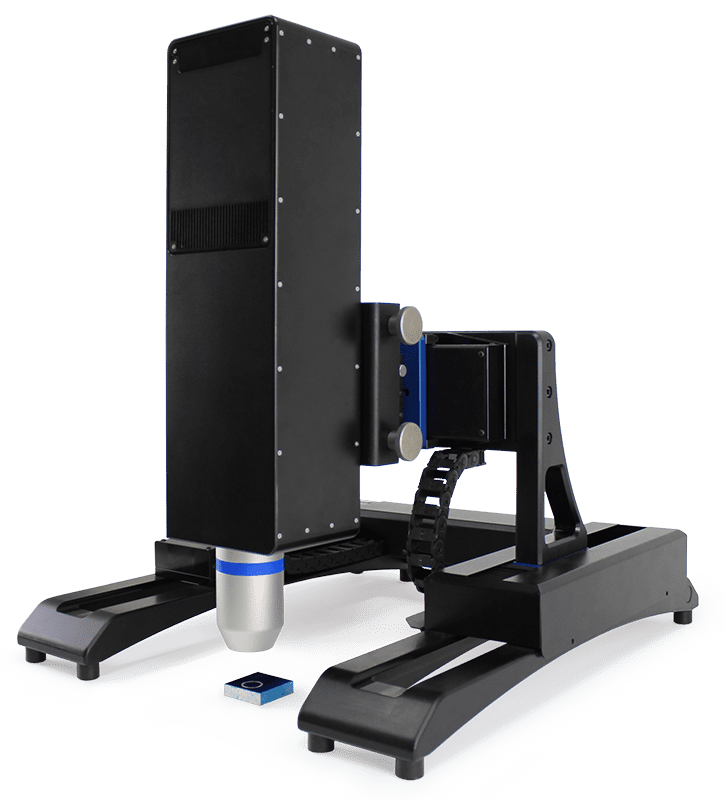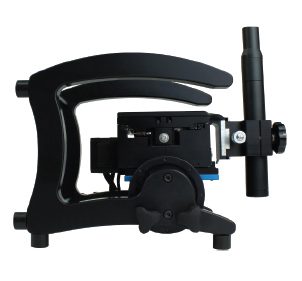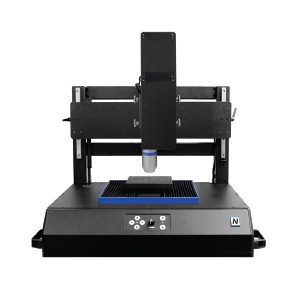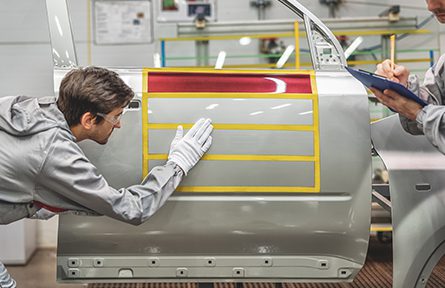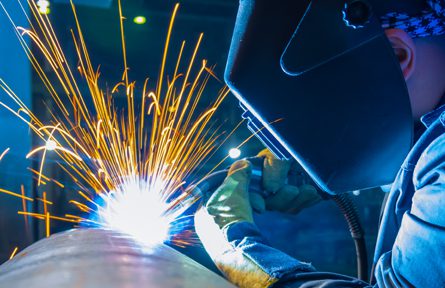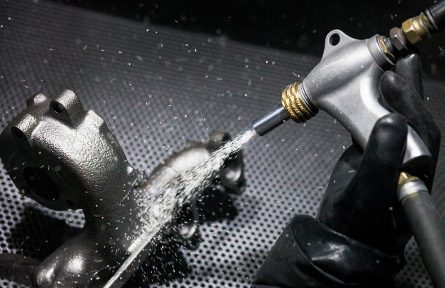
Surface Roughness Measurement
Surface roughness is an important parameter when it comes to assessing the quality of a surface finish on a material. Surface roughness measurement can help to determine whether surfaces meet industry standards and safety requirements for performance, as well as help you track process variables that might influence surface characteristics such as aging, chemical deposition, or mechanical wear. If you are involved in material engineering research and development, production process control, or quality assurance testing, then this page on surface roughness measurement will provide you with detailed information about various techniques, benefits, and drawbacks of each, explain surface roughness parameters and discuss applications. We’ll dive deep into NANOVEA instruments used for surface roughness measurements. With this comprehensive guide, you’ll be able to confidently assess your materials across all stages of their life cycles!
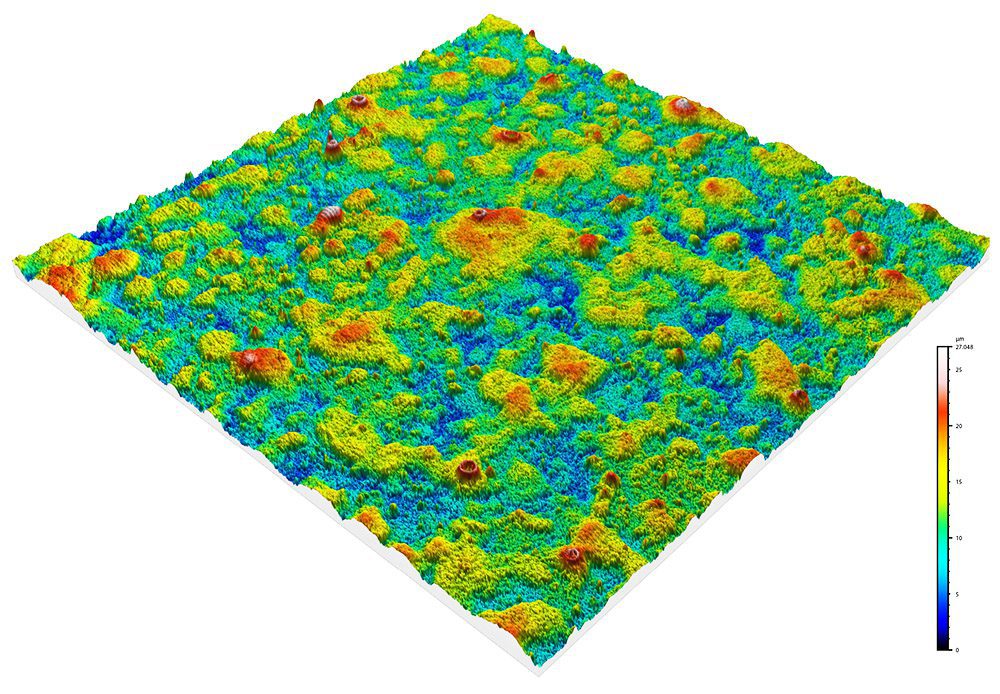
Table of Contents
Surface Roughness Testing Techniques
There are a variety of surface roughness measurement techniques available, such as stylus profilometry, optical profilometry (interferometry, laser, focus variation, and white light chromatic confocal), and atomic force microscopy. Each method offers its benefits and drawbacks, depending on factors such as the material being measured and the desired level of precision.
Stylus Profilometry
This technique involves running a fine stylus over the surface of a material, collecting data on its features, and creating a three-dimensional model of the surface. A key advantage of stylus profilometry is its ability to provide measurements of surface roughness at a relatively low cost. However, the main limitation of stylus profilometry is the difficulty in measuring soft or fragile surfaces and the potential for the stylus to damage the surface during measurement, also it may not be able to accurately capture features that are smaller than the tip of the stylus. Another major disadvantage of this technique is that it is very slow for 3d measurements and the tip will wear with time. Before selecting this method of surface roughness measurement, it’s important to consider the specifics of the material being studied and the level of precision required.
Interferometry
Interferometry offers precise measurement capabilities that are useful for surface roughness measurement, among other applications. This technique uses the interference patterns of light waves to directly measure the shape and texture of a surface. Interferometry offers precise measurement capabilities that are useful for surface roughness measurement, among other applications. Interferometry provides the best lateral accuracy and height resolution of all-optical techniques. Interferometry, when used for surface roughness measurement, may prove to be a challenging method due to several drawbacks. For one, the measurement range is limited, and sensitivity to environmental conditions can hinder accurate measurements. Additionally, the setup and alignment of the equipment must be carefully executed, requiring skill and expertise. A surface reflectivity requirement must also be met, which may not be feasible for all materials. Finally, there is limited accessibility to the measured surface, further complicating the process. Despite these drawbacks, interferometry remains a powerful technique specially to measure steps in microelectronics.
Laser Triangulation
The laser triangulation profilometry technique is a powerful tool used to examine surface roughness with high accuracy. The working principle of this technique is based on the reflection of laser light off a surface. The system measures the displacement of the reflected laser beam as the laser source moves across the surface, generating a 3D representation of the specimen. One of the main advantages of laser triangulation is its high speed and ability to measure a broad range of surfaces, from smooth to rough. However, the accuracy may vary depending on the surface material and the presence of occlusions. Overall, the laser triangulation method offers precise surface roughness measurement that can be useful in many applications.
Focus Variation
The focus variation optical technique has been developed and widely used for surface roughness measurement in industry and research fields. This optical technique works by examining the variation of focus planes to determine the distance between the object and the lens, which can then be used to quickly give a 3D image of the surface or to calculate the surface roughness. One major advantage of this technique is its ability to measure profiles with steep slopes at a fast speed, making it ideal for measuring intricate surfaces. However, it does have some disadvantages when compared to the white light chromatic confocal technique. For example, it may not be the right technique for measuring highly reflective surfaces due to its sensitivity to changes in light intensity. The software also uses algorithms to determine what is in focus or not and this can greatly affect the actual accuracy, especially on complex surfaces. It is worse than Confocal Laser Microscopy in terms of accuracy for most applications. In any case, the focus variation technique can still be a valuable quality control tool since it can image the 3D surface very quickly at a relatively low cost.
Confocal Laser Microscopy
Confocal laser microscopy is a precise method to measure surface roughness. The working principle of this technique is to use a confocal laser microscope to collect light reflected by the sample’s surface and recreate quickly three-dimensional images. It works better than interferometry on complex angular surfaces but as for interferometry, the software uses an algorithm to reconstruct the surface which adds inaccuracies. The laser technology has less accuracy than other techniques such as interferometry and white light chromatic confocal technologies. As for interferometry, it measures a small area fast but the technique requires stitching to image larger surfaces which can be very slow and add inaccuracies in the data. Overall, the confocal laser microscopy technique provides researchers with a fast powerful tool for surface roughness measurement and analysis that can be applied in various scientific fields.
White Light Chromatic Confocal
White Light Chromatic Confocal has revolutionized surface roughness measurement in many industries. This versatile measurement technique allows for high precision and accuracy without the need for physical contact, avoiding potential damage to delicate surfaces. The measurement capabilities of this optical profilometry technique are impressively diverse and accommodate various types of surfaces, including smooth, rough, curved, and textured ones. Interferometry, on the other hand, may encounter constraints when assessing specific surface types or geometries. White Light Chromatic Confocal gets its data directly from a spectrometer that measures the wavelength reflected in focus. So contrary to focus variation or interferometry, the software does not use any algorithms to reconstruct the surface. White Light Chromatic Confocal technology enables rapid data acquisition from large areas without the need for stitching, providing seamless and efficient surface measurements. In contrast, for any microscopy-based techniques, stitching makes large area measurements extremely long. The benefits of this optical profilometry technique make it a valuable tool for surface roughness measurement, and its versatile capabilities make it a go-to for engineers and scientists alike.

Atomic Force Microscopy
Atomic force microscopy (AFM) is a popular technique for analyzing surfaces in nanoscale detail, making it an essential tool in many areas of scientific research and development. It has many benefits, as it allows for precise surface roughness measurement, visualization of small-scale features, and the ability to track changes over time. It is also the best tool to measure the roughness of mirror-polished surfaces since it has the best lateral accuracy of all profilometry techniques. However, despite its advantages, there are also some drawbacks to consider. For example, the technique is very sensitive to environmental factors such as temperature and humidity. The technique also focuses on very small areas in the micron range that often is too small for real-world applications. Nonetheless, atomic force microscopy can provide invaluable insights into the nature of different surfaces and the behavior of materials at the nanoscale.
Understanding surface roughness measurement techniques is crucial for anyone involved in manufacturing, research, or development, as selecting the optimal technique for your application can help ensure high-quality products and innovative new materials.
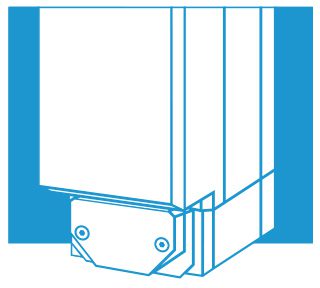
NANOVEA 3D Optical Profilometers
NANOVEA 3D Optical Profilometers are advanced, high-precision instruments designed to provide accurate and reliable surface roughness measurements. These profilometers employ cutting-edge white light chromatic confocal technology, ensuring an unparalleled level of detail and resolution in surface characterization. They offer numerous benefits, such as the ability to perform rapid, non-destructive assessments on a wide variety of surface types and geometries, making them ideal for numerous applications across various industries. Furthermore, NANOVEA profilometers feature user-friendly software, enabling researchers and professionals to quickly and efficiently analyze data, extract critical information, and make informed decisions based on their findings.
NANOVEA Standard Measurement Analysis
NANOVEA’s Standard Measurement Analysis offers a comprehensive solution for evaluating various surface parameters, ensuring accurate and reliable results. The software covers both 2D and 3D mean roughness (Ra, Sa), root means square roughness (Rq, Sq), maximum height (Rz, Sz), maximum pit height (Rv, Sv), skewness (Rsk, Ssk), kurtosis (Rku, Sku), and many more. Furthermore, it provides insights into 2D & 3D surface waviness and peak count distribution.
The software also features advanced grain analysis capabilities, including grain counting, sorting, and other related assessments. For texture alignment and analysis, the software encompasses various parameters such as aspect ratio, direction, auto-correlation, length, Fourier transform, texture direction, texture isotropy, power spectrum, and root mean square gradients, among others.
NANOVEA Advanced Measurement Analysis
NANOVEA‘s Advanced Measurement Analysis offers a range of powerful techniques to better understand material surfaces and their behavior. Motifs analysis, which identifies significant hills or valleys and locates the highest peaks and lowest valleys, serves as a valuable tool for comprehending the functional role of a surface under study.
Spectral analysis is another critical component that enables the determination of periodicity and orientation of specific patterns existing beyond roughness by revealing the frequencies present in the spectrum. The software also includes vectorization of micro-valleys and furrows, providing further insight into surface properties.
In addition, NANOVEA’s Advanced Measurement Analysis features fractal dimension analysis, which calculates the complexity of a surface. A lower number indicates a closer resemblance to a 2D plane rather than a 3D volume. By utilizing these advanced measurement analysis techniques, researchers can gain a more comprehensive understanding of material surfaces, enabling them to optimize applications and drive innovation in material development.
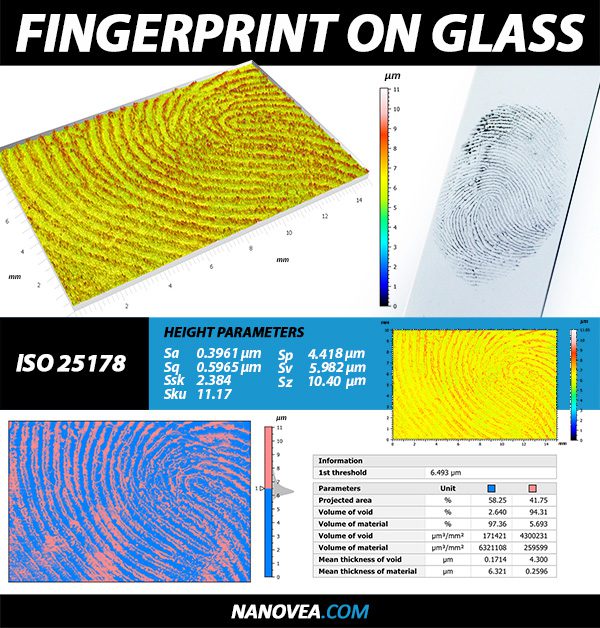
NANOVEA Specialized Measurement Analysis
Specialized Measurement Analysis caters to the unique needs of various industries, providing tailored solutions for specific applications. In the automotive sector, bearing ratio parameters such as kernel roughness depth, reduced peak height and valley depth, and upper and lower material ratios are essential for assessing component performance. The lead tightness of crankshaft seals, which is related to oil consumption, is evaluated using the Mercedes Benz engineering standard (MBN31007-7).
Another example is the measurement of the depth of grain (PG) and finish amplitude (AF) of granular plastic materials, as per the Renault D45-1856 test method. This analysis is crucial for ensuring the quality and performance of plastic components in the automotive industry.
In the cosmetic industry, wrinkle measurement plays a vital role in evaluating the effectiveness of skincare products and treatments. By offering specialized measurement analysis solutions, researchers and professionals can obtain accurate and reliable data tailored to their industry-specific needs, ultimately enhancing product quality and fostering innovation.
Surface roughness standards and specifications
Various testing standards exist to ensure the accuracy and reliability of surface roughness measurements in material characterization. NANOVEA adheres to several international standards, including:
ISO 25178 – Geometrical product specifications (GPS) — Surface texture: Areal — Part 2: Terms, definitions, and surface texture parameters
ISO 4287 – Geometrical Product Specifications (GPS) — Surface texture: Profile method — Terms, definitions, and surface texture parameters
ISO 13565 – Geometrical Product Specifications (GPS) — Surface texture: Profile method; Surfaces having stratified functional properties — Part 2: Height characterization using the linear material ratio curve
ASME B46.1 – Surface Texture (Surface Roughness, Waviness, and Lay)
NANOVEA also complies with equivalent standards from other organizations such as GB/T, DIN, JIS, NF, BSI, UNI, and UNE. By conforming to these globally recognized standards, NANOVEA ensures the quality and consistency of its testing methods, providing reliable results across numerous applications and industries.


NANOVEA SOFTWARE FEATURES
NANOVEA Software offers a comprehensive suite of features designed to facilitate seamless surface analysis and ensure accurate results. With easily defined line or area scans, users can customize their measurements to suit their specific needs. The software also includes recipe functionality for streamlined repeatability, lateral resolution control, and the ability to export raw data and images for further analysis.
The real-time display allows users to monitor the measurement process, while automatic reporting simplifies the generation of detailed documentation. Multi-language support ensures accessibility for users worldwide, and mapping capabilities enable a thorough understanding of surface topography.
The Analysis Software features an array of tools to enhance the examination of surface properties, such as filtering, leveling, thresholding, and zooming functions. Area selection and form removal tools allow for precise analysis while subtracting and comparing functions provide valuable insights into surface differences. NANOVEA Software’s robust features empower researchers and professionals to conduct in-depth surface analyses, driving innovation and enhancing product quality across various industries.
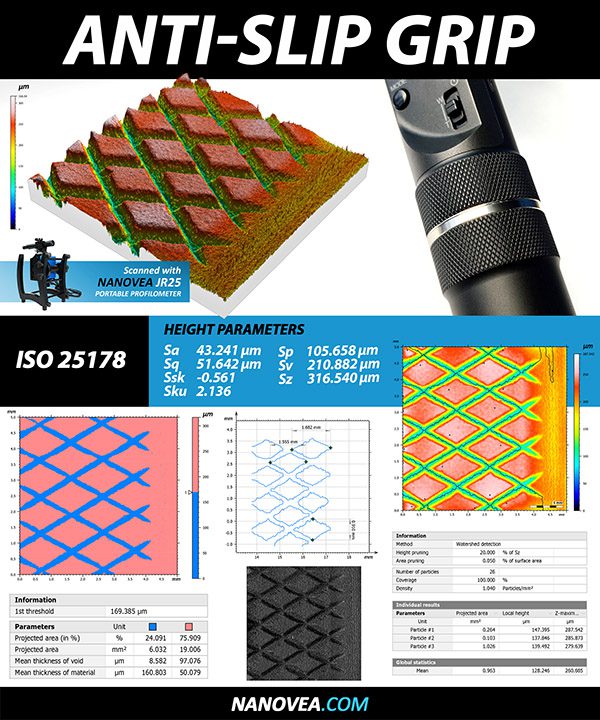
Surface roughness parameters explained
Surface roughness parameters provide essential information about the texture and quality of materials, playing a critical role in various industries and applications. These parameters help quantify surface characteristics, enabling researchers and professionals to better understand material behavior and optimize product performance. Some key surface roughness parameters include mean roughness (Ra), which represents the average deviation from the mean line or surface, and root mean square roughness (Rq), measuring the square root of the average squared deviations. Maximum height (Rz) indicates the difference between the highest peak and the lowest valley, while maximum pit height (Rv) and skewness (Rsk) describe the depth of the deepest valley and the asymmetry of the surface profile, respectively. Kurtosis (Rku) measures the sharpness and distribution of the peaks and valleys on a surface. By analyzing these surface roughness parameters, experts can gain valuable insights into material properties, ensuring optimal performance and driving innovation in material development.
Surface roughness applications
Surface roughness measurement applications are vital across various industries, as they provide critical insights into material properties and performance. By evaluating the surface texture, researchers and professionals can optimize manufacturing processes, enhance product quality, and prolong the service life of components. Surface roughness measurements are essential in industries such as automotive, aerospace, electronics, and medical devices, where precise tolerances and reliability are crucial. In these sectors, accurate surface roughness assessments ensure proper mating of parts, reduce friction and wear, and minimize the risk of component failure. Furthermore, surface roughness measurements are also important in the development of advanced coatings and materials, enabling researchers to understand how different surface textures affect properties such as adhesion, corrosion resistance, and thermal conductivity. Overall, surface roughness measurement applications play a significant role in driving innovation and maintaining high standards across a wide range of industries.
Conclusion
In conclusion, surface roughness measurement is a crucial process in the field of material science, offering invaluable insights into the properties and characteristics of surfaces. By quantifying surface roughness, manufacturers can optimize production processes and enhance product quality, while engineers can utilize this data to predict material behavior and devise effective solutions. Among the available measurement techniques, optical profilometry stands out for its high precision, non-contact nature, and versatility in measuring various surface types. Despite some limitations, the advantages of optical profilometry far outweigh the drawbacks, solidifying its position as an indispensable tool in surface roughness measurement.
With advancements in software analysis and specialized measurement options, researchers and professionals have access to comprehensive tools that facilitate accurate and reliable surface analysis. Surface roughness parameters aid in understanding material behavior, with applications spanning across industries such as automotive, aerospace, electronics, and medical devices. These applications promote innovation and uphold high-quality standards in their respective fields. Ultimately, surface roughness measurement, particularly through optical profilometry, plays a pivotal role in ensuring efficient production processes and the development of top-quality products across various industries.
